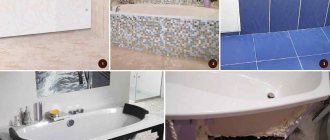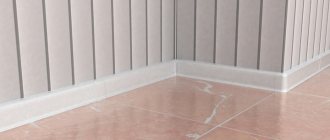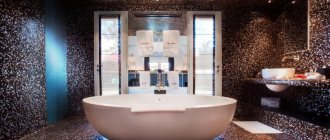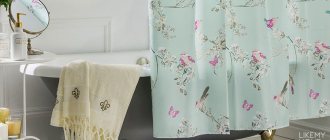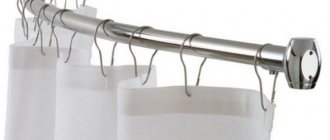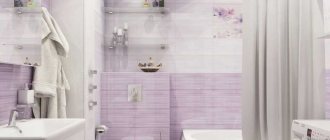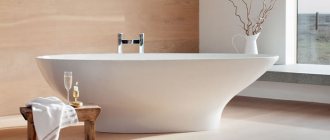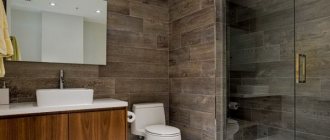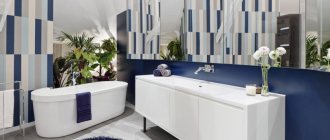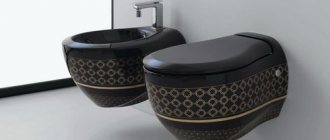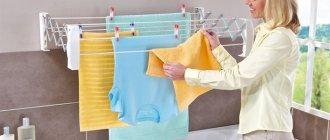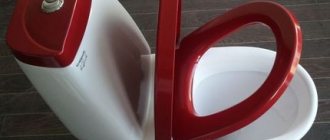Share
Tweet
+1
Pin
There are a lot of options for fencing the water treatment area and protecting the rest of the space. And one of the most popular is the use of a special curtain, which can be of various types:
- swing;
- sliding;
- folding;
- glass.
They all perform their function perfectly and perfectly complement the bathroom design style.
Purchase and installation
Diagram of the cornice mounting unit.
Although the plumbing fixture market has changed a lot in recent years, the principle of installing a bathroom curtain remains the same as it was 20-30 years ago. The classic, time-tested cornice acts as a supporting structure for it. The cornice can take the form of a smooth pipe structure or be made of strip or string and attached to both the ceiling and the walls.
The simplest and most affordable for buyers is a cornice in the form of a round or oval pipe. It is easy to install, can be selected for a bathtub of any configuration, and, if desired, can be made at home from any chrome-plated or polished pipe.
The principle of installing such a cornice is very simple. The telescopic pipe expands with its ends into the opposite walls of the room, then, using a clamping spring or threaded connection, is tightly fixed at the ends of the walls. Subsequently, using hooks or clips, it allows you to attach any flexible sliding curtains to its structure.
Types of fastening
There are three ways to secure the curtain:
- String mount . This is the most common fastening method. But it should be remembered that it is only suitable if the bathtub has a side, under which you can easily hide the entire structure.
- Metal frame . Very convenient fastener, as it is durable. These metal curtain rods have a special anti-corrosion coating and come in different shapes. They can be straight, oval or round.
- Baguette with nuts . Ready-made kits are sold in stores, which simplifies the process of designing a bathtub for people who do not want to create a mounting system themselves.
Telescopic blinds
Diagram of a telescopic sliding door for a bathtub.
Protective curtains for the bathroom today are produced from:
- woven materials (cotton, linen, silk and other fabrics that have a hydrophobic impregnation and can repel water);
- opaque, tempered, safe to use glass;
- glossy and matte dense plastic;
- soft dense polyester, vinyl and polyethylene;
- tree.
These are the most common materials from which a curtain can be made. However, if you decide to make this accessory yourself, then your design fantasies may be more exotic. With a variety of finishing materials for the bathroom, you can express your own individuality and, for example, pick up a brush, apply a landscape to a factory curtain, use a ready-made sticker and make an applique on the finished curtain. Your fantasies may be limited only by the capabilities of your wallet, but not by the assortment of stores.
All about wood and woodworking – 1poderevu.ru.
What characteristics are important
When choosing curtains, you should pay attention to the following parameters:
- Moisture resistance . The material must be waterproof, because the bathroom is a place of high humidity. PVC is excellent, since curtains made of this material repel water better, unlike textile ones.
- Durability . The curtain must withstand mechanical stress, especially if you plan to use it for a long time.
- Light fastness . If the bathroom has a window through which direct sunlight enters, you need to choose a material that is most resistant to direct sunlight. But even if there is no window, it’s worth thinking about light resistance, because any material still loses color saturation over time. Properly selected material will please the eye for a long time.
- Flexibility and plasticity . Modern bathtubs come in not only rectangular shapes, but also, for example, corner ones. As a result, the method of fastening may be specific, so care must be taken in advance to ensure that the material can easily change its configuration.
Features of construction
Bathroom curtains made of tempered glass can turn a bathing tank into a sealed hydrobox, replacing a spacious shower stall.
The principle of opening compartment curtains.
In this case, the glass curtain panel is attached to three walls of the bathroom, and the sliding curtains for the bathroom are selected according to the type and size of the bathtub bowl.
Manufacturers today produce curtains in several placement options for various bath designs. Therefore, the sliding curtain can be:
- rectangular (with two front sliding panels);
- corner (with one retractable and one fixed panel);
- prefabricated (with two movable and two fixed side panels);
- curved (with panels of any type).
Another sliding curtain can be:
- single-section;
- two-section;
- three-section;
- four-section;
- multi-sectional.
Sliding curtains are mounted using upper and lower guides. The upper structure of the guide is fixed on vertical profiles mounted on the walls of the bathroom (approximately at a height of 1.2 -1.4 m). The lower one, as a rule, is installed on the rim or frame of the bathtub.
The movable curtain panels are attached to the upper profile and move along it using rollers. The bottom of the curtain panel may or may not have rollers. If there are no rollers, it will be held by the walls of the guide.
It is convenient to install a glass curtain in bathrooms where the bathtub is placed between the walls and does not have free space.
If the bathtub is not located close to the surface of the walls, you can use a hybrid option for installing curtains, namely, install a fixed end wall from a single sheet of curtain, and use sliding double, triple or multi-panel curtains for the front surface.
The most popular material for making bathroom curtains is tempered glass.
Bathroom wall cladding with acrylic glass
This modern installation system for wall cladding with acrylic glass is called Renovetro. Its undeniable advantages over traditional methods of repair and finishing are manufacturability, ease and speed of installation, and the absence of noisy and dirty work.
In our example, instead of an old tiled bathtub, a functional shower cabin is equipped and stylishly decorated in the spirit of modern design. Its back and side walls, finished with tinted acrylic glass, give the interior a completely different look than the previous dilapidated and long-out of fashion tiles.
The system includes sheets of acrylic glass in six color options (white, black, grey, brown, green, red), measuring 100 x 244 cm and 4 mm thick, decorative aluminum profiles 250 cm long with a discreet design in silver or chrome and additional accessories (installation kit): acrylic glue, double-sided adhesive tape, adjusting wedges.
Rigid structures
Before making a final decision on installing rigid sliding structures, you should thoroughly study the structure of the existing bathroom. Most often, especially in older homes, the bathroom is compact in size, so the existing faucet serves both to fill the bathtub and to operate the sink. In this case, installing a rigid curtain may make the bathroom unusable or require the installation of separate faucets for the washbasin and bathtub.
Material selection
To make a fabric curtain for the bathroom with your own hands, you first need to choose the appropriate material. It has certain requirements:
- The fabric should be both waterproof and water-repellent - the curtain will be installed next to the bathroom and should protect the walls, floor and furniture in the room from moisture.
- The material should be easy to clean. The product will be in constant contact with water, cosmetics and soap. There will definitely be smudges on the surface of the product. You need to choose a material that can easily withstand cleaning with detergents.
- The fabric should be such that you can work with it yourself using the tools and equipment you have at home.
Glass curtains
Scheme of a corner rod for a curtain in the bathroom.
There are various options for installing glass curtains: stationary, retractable and corner.
The listed curtain options may have different surfaces:
- polished one-color;
- wavy or corrugated;
- film;
- polished;
- painted;
- with print.
Each type of curtain has its own installation features:
- Stationary curtain. This type of curtain is installed on the surface of the wall and the side of the bathroom. In this case, a strong protective plane is created that protects the bathtub from the inside, but does not guarantee that splashes of water will not fall on the floor and bathroom objects.
- Retractable curtain. This type of curtain design is very similar to a folding curtain, but is represented by one panel. A retractable shade is installed in the same way as a folding shade and has the same limitations. Its disadvantage is that it requires a long distance for a sealed fit to the wall. An advantage can be called the fact that the hinges of the curtain design can withstand the load of only one web; accordingly, they wear out less than double-panel, triple-panel and multi-panel structures.
- Corner curtain. This type of curtain is used in a bathroom, when the bathtub is adjacent to the junction of two walls, or more precisely, one of the ends of the bathtub remains free. With this configuration, as a rule, an option is chosen where the long side of the bathtub is covered with a continuous panel, and a door is installed at the free end, equal to the width of the bathtub, which can be represented by a single-panel, double-panel or multi-panel curtain. In the case of a multi-leaf design of the end, one of the doors can be permanently attached, while the others can have a sliding or door opening. Corner installation of curtains is often used in acrylic bathtubs. A variant of this installation is the case where the curtains do not cover the entire volume of the bathroom, but only the part adjacent to the mixer and the place where the shower is attached.
Design
There are a large number of models available on the market, and each of them has its own unique and inimitable design. But we can give some advice to those who are just thinking about buying.
Plastic products are most suitable for bathtubs with asymmetrical shapes. Plastic and metal are now practically no different from each other in appearance. But the first type of material weighs much less and is easier to bend into any possible shape. In addition, it is plastic structures that are easier to replace with new ones if deformations appear in one of the parts.
Glass bath doors instead of curtains
Patterned glass on some sections of the wall is a fresh touch to any design. Or you can choose the entire structure so that it harmonizes with its surroundings and successfully complements it. It is easy to match the color of the tile wall to the glass; it is simply coated with different paints. True, such material cannot be bent, so it is hardly suitable for plumbing fixtures with a complex shape in terms of geometry.
When the toilet and bathroom are combined, you can choose types of screens with a matte or painted surface. Then the person who decided to take a shower will not be visible.
But a separate bathtub can be closed without any problems with ordinary transparent doors. They also do an excellent job of protecting tiles from splashes. You can place them in a small room, but the usable area will definitely not be reduced.
Installation nuances
The installation of any curtain depends on the type and design of the curtain itself. However, all types of existing curtains are fixed to the edge of the bathroom. For the most part, fastening is done using self-tapping screws.
In this regard, acrylic standard bathtubs of a simple configuration benefit, since holes are easily made in them and are not afraid of water and corrosion.
Holes for attaching curtains are drilled according to the recommended instructions provided by the manufacturer. However, usually profiles are initially applied to the walls and edges of the bathroom, then marked in place, and only then secured using self-tapping screws or decorative screws. It is better to make the holes with a sharp drill of a smaller diameter, and then screw in the fasteners.
When the profile is firmly screwed to the wall and edges of the bathtub, it should be adjusted using the adjustment screw. Doors and panels are installed in the adjusted grooves of the profile. The movable structures are placed in a working position corresponding to the configuration of the bathtub.
Additional factors
Not only the screen itself, but also the fittings and other components should be made from moisture-resistant and corrosion-resistant materials.
Glass shower doors
Polycarbonate and glass remain the materials most widely used among buyers today. Although the possible variants of this design are not limited to them. Each material has its own characteristics, disadvantages and advantages.
Glass shower screen
Low cost and low weight are considered the main advantages of polycarbonate. Thanks to these properties, a variety of shapes can be created on its basis. That’s why shower doors are distinguished by a variety of possible design solutions. But in terms of strength and durability, it is noticeably inferior to its competitor. And it is not able to withstand even small mechanical loads in domestic conditions.
It is more difficult to install doors made of glass. And their cost is quite high. But the durability and reliability are higher. The main material for production is tempered glass, with a thickness of at least 6 mm. In everyday conditions, such structures cannot be damaged, even scratched.
